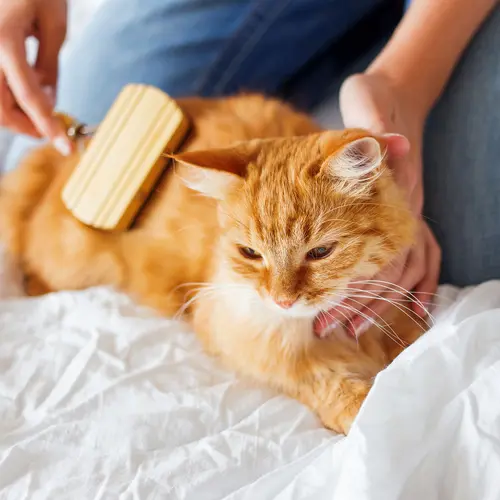Cats aren’t big droolers. While a little drool is nothing to worry about, a waterfall can be a sign your kitty is sick.
Here are some reasons your cat might drool too much, along with suggested treatments.
Mouth disease and tooth decay. Tartar buildup can rub on the inside of your cat’s lip, causing them to slobber. To check, pull their lip back toward their ear. Do their teeth look like concrete? Are they brown? Are the gums red, swollen, or even bleeding?
Try a professional cleaning first, and then brush their teeth daily. Have your vet check for gingivitis, mouth ulcers, and tumors.
Trouble swallowing: While playing, a string or a toy might get stuck in your cat’s mouth or wrapped around their tongue. Take the object out if it is easy to remove; otherwise, call your vet for help. Trying to remove a string that is partially swallowed, for example, could cause damage to the cat's esophagus or stomach.
Then again, your cat might want to resist swallowing just because they have a bad taste in their mouth. Maybe they didn’t quite swallow their medicine, or they licked or ate something gross like a frog or lizard.
Heatstroke: Pets with flat faces, such as Persian cats, are more likely to have heatstroke. It isn’t as common in cats as it is in other animals, though. Still, if your cat's had too much sun or not enough water, that's dangerous for them.
Always have fresh, clean water available. Make sure your cat has shady places to cool off, too. On very hot days, keep them indoors, limit their exercise, and never leave them in a parked car. Call your vet right away if you suspect heatstroke.
Stress: Open-mouth panting and breathing are signs of anxiety. Being stressed can cause your cat to drool. There may be multiple reasons for their stress. If this happens when you put them in the car to take them to the vet, try putting them in their carrier in the back seat without driving anywhere. Then, slowly work up to backing out of the driveway and driving around the block. Gradually repeat the routine as needed to ease their stress. You can also drape a breathable cloth over the carrier before heading out, so they don’t panic.
You can also talk to your vet about pheromones or medications to calm them for travel. (Feliway and/or Gabapentin are two options)
Organ disease: As pets age, they're more likely to get sick. Liver and kidney diseases can cause drooling, too. Vets suggest annual checkups (for older pets it is best to visit the vet at least twice a year) to diagnose and treat such diseases early.
Poisonous plants: Common plants like tulips, azaleas, and chrysanthemums can make your cat drool, as well as make them sick, so don't let your feline friend eat them. For a list of poisonous plants, check with the American Society for the Prevention of Cruelty to Animals (ASPCA).
Upper respiratory infections: Drooling can signal an infection of the nose, throat, or sinuses. Cats that live in homes or shelters with other pets have a higher risk. Stress is another factor.
Nausea: Organ disease, and exposure to toxins, among other things, may lead to nausea, which in turn can cause drooling.
Only your vet should treat an infection. But you can take steps to protect your cat from getting one: Keep them up to date on vaccines, indoors, and away from other pets, and wash your hands between handling different animals.
Only you know your cat’s normal behavior. If it changes for more than a day, they seem stressed or aren't eating and playing as usual, let your vet know.


